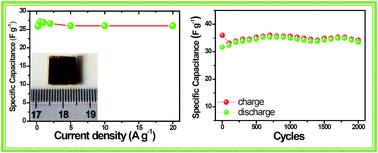All solid supercapacitors based on an anion conducting polymer electrolyte†
Abstract
In this paper, KOH doped polybenzimidazole (PBI–KOH), an anion conducting polymer electrolyte, has been employed to demonstrate the possibility of fabricating alkaline all solid supercapacitors. This is different from the conventional gel-electrolyte based quasi-solid supercapacitors. Symmetric devices assembled using commercial activated carbon based electrodes and PBI–KOH electrolytes exhibit a high rate capability with specific capacitance retention above 90% when the discharge current density increased from 0.5 to 20 A g−1. However, PBI–KOH suffers from low cycling stability with a rapid decrease in specific capacitance in the first 1000 cycles. By adding a binder or narrowing the potential window, the cycling stability could be improved. The best device shows a quite stable performance during the first 2000 cycles with specific capacitance degradation of less than 5%. An asymmetric (or hybrid) device has been assembled using activated carbon and Ni(OH)2 as electrode materials, which exhibits a relative high specific energy of 37.1 W h kg−1. These results strongly recommend the great potential of solid anion conducting polymer electrolytes in developing alkaline all solid supercapacitors.


 Please wait while we load your content...
Please wait while we load your content...